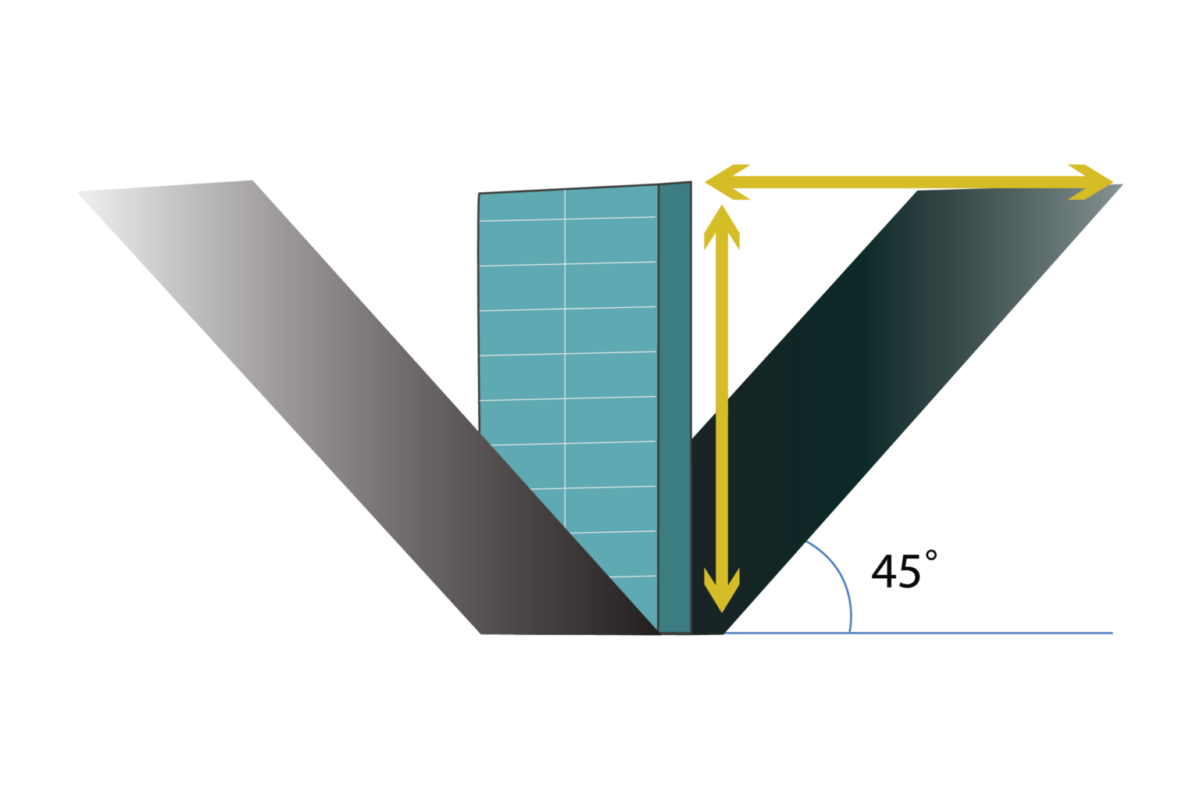From pv magazine global
An international research team has developed a novel radiative cooling method for vertical solar panels that uses V-shaped mirrors tailored for the thermal management on both sides of the PV panels.
Radiative cooling occurs when the surface of an object absorbs less radiation from the atmosphere and emits more. As a result, the surface loses heat and a cooling effect can be achieved without the need for power.
“Radiative cooling facilitates the dissipation of heat from a terrestrial body to outer space and the ambient environment through thermal radiation,” the academics explained. “This cooling strategy is particularly suitable for hot PV panels as they can fully utilize the atmospheric transparency window within the 8–13 mm range, and even beyond, due to their operating temperatures being significantly higher than the ambient temperature.”
The novel cooling approach is dubbed v-PV and employs two 45-degree inclined mirrors on the two sides of a PV module. In the front size, an aluminum mirror was used, letting incident sunlight reflect on the module, while the thermal radiation from the front side can be directed to the sky. On the back side of the panel, a spectral selective reflector was installed, enabling the thermal radiation to be directed to the sky while preventing the back of a module from heating up by the scattered sunlight.
To test the proposed method, the scientists conducted three experiments – one in laboratory conditions, another in Buffalo, New York and a third in Thuwal, Saudi Arabia.
In the lab experiment, they used the v-PV with an 18 V polycrystalline module under one sun illumination and in a 1,000 Ω resistor to simulate a realistic operational scenario.
“Double-sided radiative cooling can significantly reduce the operating temperature of a PV module by as much as 51.08 F (10.6 C), leading to an increase in the output voltage by 0.80 V,” they found.
Then, they conducted a field test in New York using the same system configuration. They compared the performance of a cooled module with that of a panel without the spectral selective mirror on the rear side (sv-PV) and that of a horizontal reference panel with no mirrors (h-PV).
“At 12:40, when solar irradiance peaked, v-PV recorded a temperature of 59.6 C, which was still 9 C lower than the h-PV system (68.6 C) and 4.7 C lower than the sv-PV module (64.3 C),” they explained. “These different operating temperatures affected the output. The v-PV achieved a Voc of 18.49 V, surpassing h-PV by 0.59 V (17.9 V) and sv-PV system by 0.20 V (18.29 V).”
The group emphasized that due to its vertical orientation and V-shaped beaming mirror, v-PV receives higher solar irradiance than h-PV at latitudes above 46 degrees. “The v-PV design can achieve significantly higher output in high latitude regions such as Europe and Canada,” they said.
In the Saudi testing field, the researchers tested a modified version of the system. They adjusted the installation angles of the solar panels to 22 degrees and the selective reflectors on the rear side to 0 degrees. The front mirror stayed unchanged at 45 degrees.
The test showed that the surface temperature of the v-PV was 54.5 C, compared to 54.7 C of the h-PV and 55.7 C of the sv-PV. That also translated to improved power, as the different setups reached maximum power of 5.77 W, 4.94 W, and 5.67 W, respectively. Conversion efficiency was 10.53% for v-PV, 10.31% for h-PV, and 10.41% for the s-PV.
“When solar irradiance collection efficiency of the solar panel was enhanced by 15% compared to an aligned, horizontal PV module, the proposed v-PV system maintained a slightly lowered operating temperature of 0.2 C, corresponding to an increase in the maximum power output by 16.8%,” the scientists asserted.
The novel cooling tech was presented in the study “Radiative cooling for vertical solar panels,” published in iScience by academics from Saudi Arabia’s King Abdullah University of Science and Technology (KAUST), as well as the State University of New York at Buffalo and the University of Texas at Dallas in the United States.
Radiative cooling was recently applied to solar panel cooling by researchers from Shanghai Jiao Tong University in China, Purdue University in the United States, the Catalan Institute of Nanoscience and Nanotechnology and the Instituto de Ciencia de Materiales in Spain, and the Jordan University of Science and Technology and the Australian College of Kuwait.
This content is protected by copyright and may not be reused. If you want to cooperate with us and would like to reuse some of our content, please contact: editors@pv-magazine.com.








By submitting this form you agree to pv magazine using your data for the purposes of publishing your comment.
Your personal data will only be disclosed or otherwise transmitted to third parties for the purposes of spam filtering or if this is necessary for technical maintenance of the website. Any other transfer to third parties will not take place unless this is justified on the basis of applicable data protection regulations or if pv magazine is legally obliged to do so.
You may revoke this consent at any time with effect for the future, in which case your personal data will be deleted immediately. Otherwise, your data will be deleted if pv magazine has processed your request or the purpose of data storage is fulfilled.
Further information on data privacy can be found in our Data Protection Policy.